On the 28th January 2015, the DECC launched a new policy emissions tool, so everyone can design policies to save the world from dangerous climate change. I thought I would try it out. By simply changing the parameters one-by-one, I found that the model is both massively over-sensitive to small changes in input parameters and is based on British data. From the model, it is possible to entirely eliminate CO2 emissions by 2100 by a combination of three things – reducing the percentage travel in urban areas by car from 43% to 29%; reducing the average size of homes to 95m2 from 110m2 today; and for everyone to go vegetarian.
The DECC website says
Cutting carbon emissions to limit global temperatures to a 2°C rise can be achieved while improving living standards, a new online tool shows.
The world can eat well, travel more, live in more comfortable homes, and meet international carbon reduction commitments according to the Global Calculator tool, a project led by the UK’s Department of Energy and Climate Change and co-funded by Climate-KIC.
Built in collaboration with a number of international organisations from US, China, India and Europe, the calculator is an interactive tool for businesses, NGOs and governments to consider the options for cutting carbon emissions and the trade-offs for energy and land use to 2050.
Energy and Climate Change Secretary Edward Davey said:
“For the first time this Global Calculator shows that everyone in the world can prosper while limiting global temperature rises to 2°C, preventing the most serious impacts of climate change.
“Yet the calculator is also very clear that we must act now to change how we use and generate energy and how we use our land if we are going to achieve this green growth.
“The UK is leading on climate change both at home and abroad. Britain’s global calculator can help the world’s crucial climate debate this year. Along with the many country-based 2050 calculators we pioneered, we are working hard to demonstrate to the global family that climate action benefits people.”
Upon entering the calculator I was presented with some default settings. Starting from a baseline emissions in 2011 of 49.9 GT/CO2e, this would give predicted emissions of 48.5 GT/CO2e in 2050 and 47.9 GT/CO2e in 2100 – virtually unchanged. Cumulative emissions to 2100 would be 5248 GT/CO2e, compared with 3010 GT/CO2e target to give a 50% chance of limiting warming to a 2°C rise. So the game is on to save the world.
I only dealt with the TRAVEL, HOMES and DIET sections on the left.
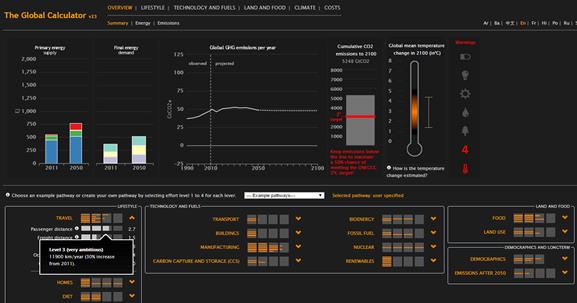
I went through each of the parameters, noting the results and then resetting back to the baseline.
The TRAVEL section seems to be based on British data, and concentrated on urban people. Extrapolating for the rest of the world seems a bit of a stretch, particularly when over 80% of the world is poorer. I was struck first by changing the mode of travel. If car usage in urban areas fell from 43% to 29%, global emissions from all sources in 2050 would be 13% lower. If car usage in urban areas increased from 43% to 65%, global emissions from all sources in 2050 would be 7% higher. The proportions are wrong (-14% gives -13%, but +22% gives +7%) along with urban travel being too high a proportion of global emissions.
The HOMES section has similar anomalies. Reducing the average home area by 2050 to 95m2 from 110m2 today reduces total global emissions in 2050 by 20%. Independently decreasing average urban house temperature in 2050 from 17oC in Winter & 27oC in Summer, instead of 20oC & 24oC reduces total global emissions in 2050 by 7%. Both seem to be based on British-based data, and highly implausible in a global context.
In the DIET section things get really silly. Cutting the average calorie consumption globally by 10% reduces total global emissions in 2050 by 7%. I never realised that saving the planet required some literal belt tightening. Then we move onto meat consumption. The baseline for 2050 is 220 Kcal per person per day, against the current European average of 281 Kcal. Reducing that to 14 Kcal reduces global emissions from all sources in 2050 by 73%. Alternatively, plugging in the “worst case” 281 Kcal, increases global emissions from all sources in 2050 by 71%. That is, if the world becomes as carnivorous in 2050 as the average European in 2011, global emissions from all sources at 82.7 GT/CO2e will be over six times higher the 13.0 GT/CO2e. For comparison, OECD and Chinese emissions from fossil fuels in 2013 were respectively 10.7 and 10.0 GT/CO2e. It seems it will be nut cutlets all round at the climate talks in Paris later this year. No need for China, India and Germany to scrap all their shiny new coal-fired power stations.
Below is the before and after of the increase in meat consumption.
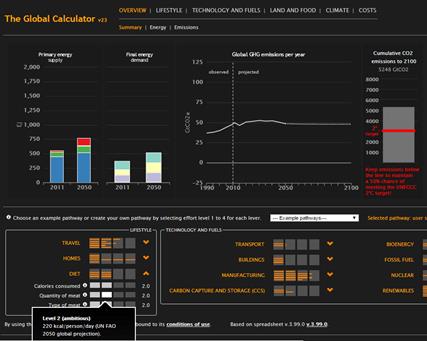
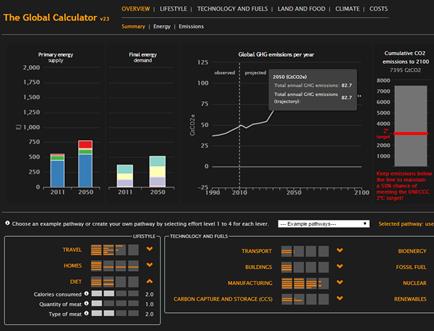
Things get really interesting if I take the three most sensitive, yet independent, scenarios together. That is, reducing urban car use from 43% to 29% of journeys in 2050; reducing the average home area by 2050 to 95m2 from 110m2; and effectively making a sirloin steak (medium rare) and venison in redcurrant sauce things of the past. Adding them together gives global emissions of -2.8 GT/CO2e in 2050 and -7.1 GT/CO2e in 2100, with cumulative emissions to 2100 of 2111 GT/CO2e. The model does have some combination effect. It gives global emissions of 3.2 GT/CO2e in 2050 and -0.2 GT/CO2e in 2100, with cumulative emissions to 2100 of 2453 GT/CO2e. Below is the screenshot of the combined elements, along with a full table of my results.
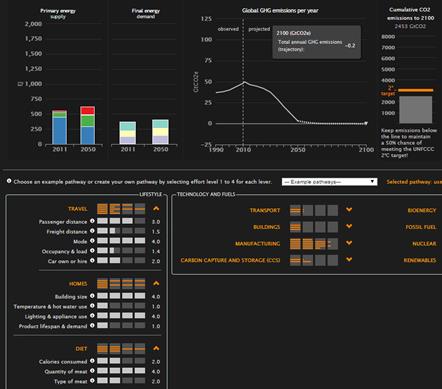

It might be great to laugh at the DECC for not sense-checking the outputs of its glitzy bit of software. But it concerns me that it is more than likely the same people who are responsible for this nonsense are also responsible for the glossy plans to cut Britain’s emissions by 80% by 2050 without destroying hundreds of thousands of jobs; eviscerating the countryside; and reducing living standards, especially of the poor. Independent and critical review and audit of DECC output is long overdue.
Kevin Marshall
A spreadsheet model is also available, but I used the online tool, with its’ excellent graphics. The calculator is built by a number of organisations.
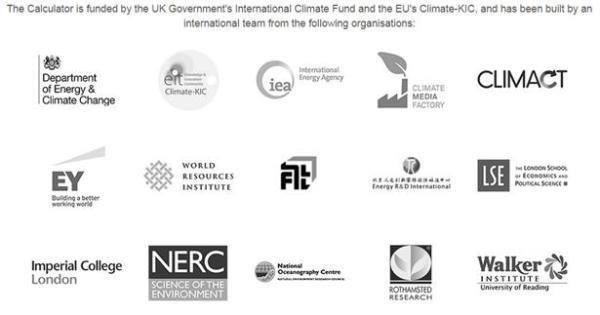
tallbloke
/ 29/01/2015Reblogged this on Tallbloke's Talkshop and commented:
.
.
Kevin Marshall demonstrates the fraudulence of DECC’s new online CO2 reduction model. YOUR money is used to propagandise and tax YOU with fraudulent pseudoscience. Use your influence as a voter on May 7th to end this nonsense. UKIP will abolish DECC, saving the taxpayer £9billion a year by 2020.
phillipbratby
/ 29/01/2015You have to wonder how much taxpayers’ money it took to produce this piece of cr@p (DECC’s Dumb Global Calculator Model that is)?
manicbeancounter
/ 29/01/2015Phillip
Is this something that a FOI could ascertain?
More relevant, is additional funding from partisan organisations.
wolsten
/ 29/01/2015Reblogged this on Wolsten and commented:
Kevin Marshall has a play with DECC’s new toy and shows that the Department for Extreme Climate Claims has found yet another ingenious way to stick two fingers up at the NHS and most other departments forced to spend within their means. DECC is literally spending billions as if there were no tomorrow – perhaps they really do know something we don’t?
Doug Proctor
/ 29/01/2015Observations vs implications: you are brilliant! Arr the longterm planners as technically negligent in ground truthing as the app designer here? Frightening thought.
Or … do they care? Is it a throwaway PR stunt? And again, what might this say about long term plans? All political posturing?
manicbeancounter
/ 29/01/2015I do not think that it is political posturing, or a PR stunt. Some economists have long believed that it is possible to describe the economy in a model – a series of equations. They are wrong. Any empirical relationships are short-lived and rather lose and difficult to measure. Further, those relationships do not fit together into a coherent system, due to the underlying structure of economies being in permanent transition. So any model of the economic world, that looks decades into the future will not hang together, or will be totally unrelated to the real world, or have elements of both like this global calculator.
With this in mind, it is just a matter of analysis to see where the model falls apart. This particular model easily falls apart, as it has plenty of tell-tale prejudices of particular mindset.
Richard Mallett
/ 29/01/2015Considering that the average global temperature change from 1880 to 2014 (from NCDC, GISS and HadCRUT4) is +0.65 C per century, which barely registers on their thermometer, the whole thing seems rather pointless.